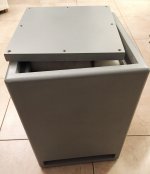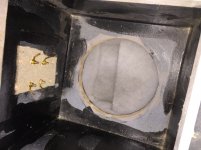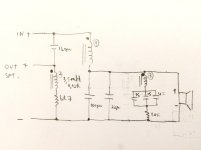My next project is the restoration of a home subwoofer that was originally built in the early '90. It is a bit challenging for me because I don't have experience on speaker builds. The cabinet is a compound type with a 8 inches driver.
The original speaker is a 8 inches dual coils Philips AD 20250 SW4. The foam suspension is completely gone. The crossover needs a rebuild because the components were hot-glued on the inside of the cabinet and the glue has come lose by now. It was also designed for different satellite speakers. The new ones are a pair of Q Acoustics 3010: 68Hz low frequency response, 6 ohm nominal impedence. I mostly play jazz and classical music at low volume.
My first issue is to repair the woofer, or to find a woofer that will match the existing cabinet. I'm not sure about the repair. A new 8-inch foam suspension only costs about 10 euro on ebay, but the speaker is a cheap one to start with, and I guess that a repair will only make it worse. A new speaker seems to be a better choice (am I wrong?) but I don't know were to start the search. The speaker is firing downward, and is mounted on a internal dividing wall at around the middle of the cabinet. The upper sealed chamber, facing the rear of the cone, measures 26x26x21cm; that's about 14 liters (0.5 cubic foot). The lower chamber, with the output port, has a volume of 12 liters excluding the reflex port. The port has a rectangular section with a mouth of 26x3 cm and a lenght of 15 cm. The upper chamber is completely filled with syntetic fiber; the bottom chamber is lined with the same material.
The other issue is the crossover. This subwoofer has been designed to work on a classic stereo system with tube amplification. I guess this explains why the crossover is so big and complex. I've reverse engineered the schematic on the attached picture. The original installation inside the cabinet is unpractical, because the 6 iron cored inductors are too big to be secured in a sound way. If I should retain this crossover, I will reassemble it in a external box. I'm starting to believe that a better way may be to forget the crossover completely, connect the Q Acoustic 3010 directly to the stereo amplifier, and use a dedicated amplifier for the sub channel instead (behind a lowpass filter). Any better ideas?
The original speaker is a 8 inches dual coils Philips AD 20250 SW4. The foam suspension is completely gone. The crossover needs a rebuild because the components were hot-glued on the inside of the cabinet and the glue has come lose by now. It was also designed for different satellite speakers. The new ones are a pair of Q Acoustics 3010: 68Hz low frequency response, 6 ohm nominal impedence. I mostly play jazz and classical music at low volume.
My first issue is to repair the woofer, or to find a woofer that will match the existing cabinet. I'm not sure about the repair. A new 8-inch foam suspension only costs about 10 euro on ebay, but the speaker is a cheap one to start with, and I guess that a repair will only make it worse. A new speaker seems to be a better choice (am I wrong?) but I don't know were to start the search. The speaker is firing downward, and is mounted on a internal dividing wall at around the middle of the cabinet. The upper sealed chamber, facing the rear of the cone, measures 26x26x21cm; that's about 14 liters (0.5 cubic foot). The lower chamber, with the output port, has a volume of 12 liters excluding the reflex port. The port has a rectangular section with a mouth of 26x3 cm and a lenght of 15 cm. The upper chamber is completely filled with syntetic fiber; the bottom chamber is lined with the same material.
The other issue is the crossover. This subwoofer has been designed to work on a classic stereo system with tube amplification. I guess this explains why the crossover is so big and complex. I've reverse engineered the schematic on the attached picture. The original installation inside the cabinet is unpractical, because the 6 iron cored inductors are too big to be secured in a sound way. If I should retain this crossover, I will reassemble it in a external box. I'm starting to believe that a better way may be to forget the crossover completely, connect the Q Acoustic 3010 directly to the stereo amplifier, and use a dedicated amplifier for the sub channel instead (behind a lowpass filter). Any better ideas?
Attachments
Hi there p: As start for replacing the Philips DVC driver, can you measure the dc resistance (Re) of the Philips driver. This will lead to a best estimate of the impedance for a replacement driver. Your drawing of a circuit diagram does not show how the dual voice coils are connected. They could be either series (4+4 ohms for 8-ohms) or (8 parallel with 8 for 4-ohms). 4-ohm DVC's are common...see Parts Express or Sonix Electronics web sites. Re-foaming cost is really low, as is replacing stuffing and externally mounting xover is an easy fix. I'd start the lowest cost project first, see how it sounds and go from there...regards, Michal
The DC resistence of each coil is 4 ohm.
This subwoofer has two identical sets of inputs and outputs connectors, and I've drawn the schematic of one channel only. The other channed is identical and drives the second woofer coil. The whole crossover has therefore 6 iron core inductors, 4 resistors and 12 capacitors. I will follow your advice about starting with the lowest cost repair first. Maybe this kind of old fashioned stereo passive subwoofers is not up to current standards anymore, so a upfront expense for a new driver may be a bad choice afterall. I've found a Ciare YBR200 foam suspension and I will try to install it on the old driver. I've tried this repair in the past with another woofer, but I got problems centering the cone. I've now checked a few online tutorials and they suggest to carefully cut away the dust cap and put some paper between the speaker coil and the pole to block and center the cone while the glue is setting; then remove the paper and glue the dust cap back in place. I will use general purpose clear glue.
This subwoofer has two identical sets of inputs and outputs connectors, and I've drawn the schematic of one channel only. The other channed is identical and drives the second woofer coil. The whole crossover has therefore 6 iron core inductors, 4 resistors and 12 capacitors. I will follow your advice about starting with the lowest cost repair first. Maybe this kind of old fashioned stereo passive subwoofers is not up to current standards anymore, so a upfront expense for a new driver may be a bad choice afterall. I've found a Ciare YBR200 foam suspension and I will try to install it on the old driver. I've tried this repair in the past with another woofer, but I got problems centering the cone. I've now checked a few online tutorials and they suggest to carefully cut away the dust cap and put some paper between the speaker coil and the pole to block and center the cone while the glue is setting; then remove the paper and glue the dust cap back in place. I will use general purpose clear glue.
A quick follow-up on the project.
I was unable to find a foam suspension with the same high excursion as the original 8 inches woofer, but the one I found seems to be close enough and the driver is working fine now. I scrapped the original crossover because it was a mess of hot glue, masking tape and cold solder joints, and I replaced it with a simple inductor in series with each woofer coil, and a capacitor in series to each satellite output binding post. I'm using a Q Acoustics 3010 speaker with nominal 6 ohm impedence and 68 Hz Fs so I installed two 470 uF 100V Nippon Chemicon capacitors in series back to back, this gives 235 uF. I dont'have a LCR meter at the moment, so for a starting point I rebuilt the inductor marked L1 on the schematic. A quick test does confirm that is indeed tuned in the ballpark of the correct crossover frequency. The amplificer for this small/cheap system is a flea-power single ended ECL86, with good/oversized output transformers.
The result is surprisingly good, the subwoofer is performing properly and does add the missing bottom end of the small 3010. It blends well even with this minimal 6dB/octave filtering. It definitely does not have the punch of a home theatre sub and it does not go very low, but a 3+3w amplifier and 8 inches woofer cannot give any more, I suppose.
The recovery of this old hand built sub has gone so well, that I fetched the matching satellite speakers also. This is a 5 liters two-way mini bookshelf speaker design with reflex port on the front. They have the same mix of high quality nice looking MDF cabinet and overly complex and badly built crossover. I believe that this speaker system was built for a push-pull EL84 tube amp, 15W per channel. The sound is currently a bit thin and distorted on the high frequencies. The mid/low driver is a 13W2608CP marked ATD; this should be a custom fullrange driver build by Seas to ATD specifications in the early '90. The tweeter is unmarked and does look to be a cheap one. When I cover it with the hand, I hear that it only adds a little bit on the >8KHz range, the ATD driver does most of the work. Is it worth to try to salvage the vintage ADT driver, or is best to replace both of them? Unfortunately, there seems to be no technical data about the 13W2608CP on the internet.
I was unable to find a foam suspension with the same high excursion as the original 8 inches woofer, but the one I found seems to be close enough and the driver is working fine now. I scrapped the original crossover because it was a mess of hot glue, masking tape and cold solder joints, and I replaced it with a simple inductor in series with each woofer coil, and a capacitor in series to each satellite output binding post. I'm using a Q Acoustics 3010 speaker with nominal 6 ohm impedence and 68 Hz Fs so I installed two 470 uF 100V Nippon Chemicon capacitors in series back to back, this gives 235 uF. I dont'have a LCR meter at the moment, so for a starting point I rebuilt the inductor marked L1 on the schematic. A quick test does confirm that is indeed tuned in the ballpark of the correct crossover frequency. The amplificer for this small/cheap system is a flea-power single ended ECL86, with good/oversized output transformers.
The result is surprisingly good, the subwoofer is performing properly and does add the missing bottom end of the small 3010. It blends well even with this minimal 6dB/octave filtering. It definitely does not have the punch of a home theatre sub and it does not go very low, but a 3+3w amplifier and 8 inches woofer cannot give any more, I suppose.
The recovery of this old hand built sub has gone so well, that I fetched the matching satellite speakers also. This is a 5 liters two-way mini bookshelf speaker design with reflex port on the front. They have the same mix of high quality nice looking MDF cabinet and overly complex and badly built crossover. I believe that this speaker system was built for a push-pull EL84 tube amp, 15W per channel. The sound is currently a bit thin and distorted on the high frequencies. The mid/low driver is a 13W2608CP marked ATD; this should be a custom fullrange driver build by Seas to ATD specifications in the early '90. The tweeter is unmarked and does look to be a cheap one. When I cover it with the hand, I hear that it only adds a little bit on the >8KHz range, the ATD driver does most of the work. Is it worth to try to salvage the vintage ADT driver, or is best to replace both of them? Unfortunately, there seems to be no technical data about the 13W2608CP on the internet.
- Status
- This old topic is closed. If you want to reopen this topic, contact a moderator using the "Report Post" button.


